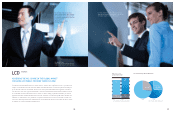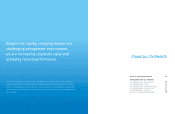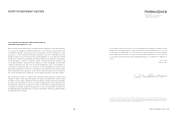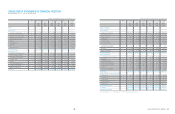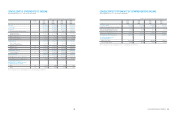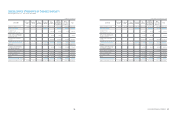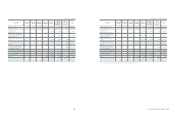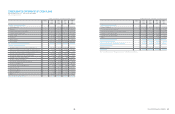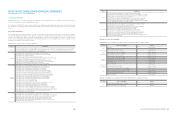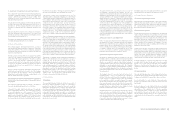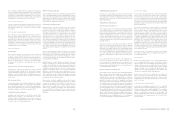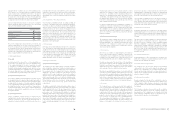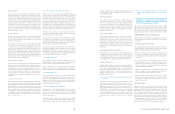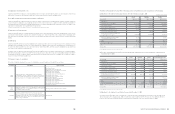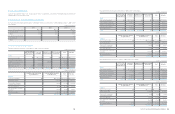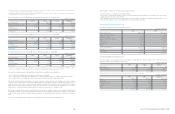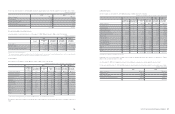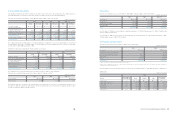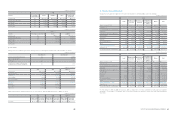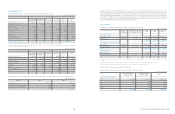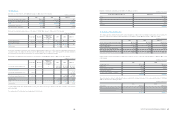Samsung 2010 Annual Report Download - page 24
Download and view the complete annual report
Please find page 24 of the 2010 Samsung annual report below. You can navigate through the pages in the report by either clicking on the pages listed below, or by using the keyword search tool below to find specific information within the annual report.44 45
NOTES TO THE CONSOLIDATED FINANCIAL STATEMENTS
On consolidation, exchange differences arising from the translation
of the net investment in foreign operations are recognized in other
comprehensive income and presented as a separate component of
equity. When a foreign operation is partially disposed of or sold, the
exchange differences that were recorded in equity are recognized in
the statement of income where there is a loss of control.
2.4 Cash Flow Statements
Cash flow statements are prepared using the indirect method.
Foreign currency cash flows have been translated into Korean
Won using the average rates of exchange for the period under
consideration.
2.5 Cash and Cash Equivalents
The Company considers all highly liquid investments with less
than three months maturity from the date of acquisition to be
cash equivalents. Bank overdrafts are considered as short-term
borrowings in the statement of financial position and treated as
financing activities in the cash flow statements, unless the overdraft
is repayable on demand and used for cash management purposes
only, in which case the overdraft is treated as cash and cash
equivalents in the cash flow statement.
2.6 Financial Assets
1) Classification
The Company classifies its financial assets in the following
categories: at fair value through profit or loss, loans and
receivables, available-for-sale, and held-to-maturity investments.
The classification depends on the terms of the instruments and
purpose for which the financial assets were acquired. Management
determines the classification of its financial assets at initial
recognition.
(a) Financial assets at fair value through profit or loss
Financial assets at fair value through profit or loss are financial
assets held for trading. A financial asset is classified in this category
if acquired principally for the purpose of selling in the short-term.
Derivatives are also categorised as held for trading unless they are
designated as hedges. Assets in this category are classified as
current assets.
(b) Loans and receivables
Loans and receivables are non-derivative financial assets with fixed
or determinable payments that are not quoted in an active market.
They are included in current assets, except for those with maturities
greater than 12 months after the end of the reporting period; such
loans and receivables are classified as non-current assets.
(c) Available-for-sale financial assets
Available-for-sale financial assets are non derivatives that are either
designated in this category or not classified in any of the other
categories. They are included in non-current assets unless an
investment matures or management intends to dispose of it within
12 months of the end of the reporting period.
(d) Held-to-maturity investments
Held-to-maturity investments are non-derivative financial assets with
fixed or determinable payments and fixed maturity that an entity has
the positive intention and ability to hold to maturity. Held-to-maturity
financial assets are included in non-current assets, except for those
with maturities less than 12 months from the end of the reporting
period, which are classified as current assets.
2) Recognition and measurement
Regular purchases and sales of financial assets are recognized
on the trade date-the date on which the Company commits to
purchase or sell the asset. Investments are initially recognized at
fair value plus transaction costs for all financial assets not carried
at fair value through profit or loss. Financial assets carried at fair
value through profit or loss are initially recognized at fair value,
and transaction costs are expensed in the statement of income.
Financial assets are derecognized when the rights to receive cash
flows from the investments have expired or have been transferred
and the Company has transferred substantially all risks and rewards
of ownership. Available-for-sale financial assets and financial assets
at fair value through profit or loss are subsequently carried at fair
value. Loans and receivables and held-to-maturity investments are
subsequently carried at amortized cost using the effective interest
method.
Gains or losses arising from changes in the fair value of the financial
assets at fair value through profit or loss category are presented in
the statement of income in the period in which they arise. Dividend
income from financial assets at fair value through profit or loss is
recognized in the statement of income when the Company’s right to
receive payments is established.
Equity instruments of which the fair value cannot be measured
reliably are recognized as cost. Changes in the fair value of monetary
securities denominated in a foreign currency and classified as
available-for-sale are analyzed between translation differences
resulting from changes in amortised cost of the security and other
changes in the carrying amount of the security. The translation
differences on monetary securities are recognised in profit or loss;
translation differences on non-monetary securities are recognised in
other comprehensive income. Changes in the fair value of monetary
and non-monetary securities classified as available-for-sale are
recognised in other comprehensive income.
When securities classified as available-for-sale are sold or impaired,
the accumulated fair value adjustments previously recognized
in equity are transferred to the statement of income. Interest on
available-for-sale financial assets calculated using the effective
interest method is recognized in the statement of income as part of
finance income. Dividends on available-for sale equity instruments
are recognized in the statement of income as part of other
operating income when the Company’s right to receive payments is
established.
3) Offsetting financial instruments
Financial assets and liabilities are offset and the net amount
reported in the statement of-financial position when there is a legally
enforceable right to offset the recognized amounts and there is an
intention to settle on a net basis, or realize the asset and settle the
liability simultaneously.
4) Impairment of financial assets
(a) Assets carried at amortized cost
The Company assesses at the end of each reporting period whether
there is objective evidence that a financial asset or group of financial
assets is impaired. A financial asset or a group of financial assets
is impaired and impairment loss is incurred only if there is objective
evidence of impairment as a result of one or more events that
occurred after the initial recognition of the asset (a ‘loss event’) and
that loss event (or events) has an impact on the estimated future
cash flows of the financial asset or group of financial assets that can
be reliably estimated.
The amount of the loss is measured as the difference between
the asset’s carrying amount and the present value of estimated
future cash flows (excluding future credit losses that have not been
incurred) discounted at the financial asset’s original effective interest
rate. The carrying amount of the asset is reduced and the amount
of the loss is recognized in the consolidated statement of income.
As a practical expedient, the Company may measure impairment on
the basis of an instrument’s fair value using an observable market
price.
If, in a subsequent period, the amount of the impairment loss
decreases and the decrease can be related objectively to an
event occurring after the impairment was recognized (such as
an improvement in the debtor’s credit rating), the reversal of
the previously recognized impairment loss is recognized in the
consolidated statement of income.
(b) Assets classified as available-for-sale
The Company assesses at the end of each reporting period whether
there is objective evidence that a financial asset or a group of financial
assets is impaired. In the case of equity investments classified as
available-for-sale, a significant or prolonged decline in the fair value
of the security below its cost is also evidence that the assets are
impaired. If any such evidence exists for available-for-sale financial
assets, the cumulative loss-measured as the difference between
the acquisition cost and the current fair value, less any impairment
loss on that financial asset previously recognized in profit or loss-is
removed from equity and recognized in the consolidated statement
of income. Impairment losses on equity instruments recognized in
the consolidated statement of income are not reversed through the
consolidated statement of income. If, in a subsequent period, the fair
value of a debt instrument classified as available-for-sale increases
and the increase can be objectively related to an event occurring after
the impairment loss was recognized in profit or loss, the impairment
loss is reversed throughthe consolidated statement of income.
2.7 Trade Receivables
Trade receivables are amounts due from customers for merchandise
sold or services performed in the ordinary course of business. If
collection is expected in one year or less (or in the normal operating
cycle of the Company if longer), they are classified as current assets.
If not, they are presented as noncurrent assets. Non-current trade
receivables are recognized initially at fair value and subsequently
measured at amortized cost using the effective interest method, less
provision for impairment.
A provision for impairment of trade receivables is established
based on a periodic review of all outstanding amounts when
there is evidence that the Company will not be able to collect
all amounts due according to the original terms of receivables.
Significant financial difficulties of the debtor, probability that the
debtor will enter bankruptcy or financial reorganization, and default
or delinquency in payments are considered indicators that a trade
receivable is impaired. The carrying amount of the asset is reduced
through the use of an allowance account, and the amount of loss
is recognized in the statement of income within selling, general and
administrative expenses. When a trade receivable is uncollectible,
bad debts are written off against the allowance account for trade
receivables. Subsequent recoveries of amounts previously written
off are credited against selling, general and administrative expenses
in the statement of income.
In the event of sale of receivables and factoring, the Company
derecognizes receivables when the Company has given up control
or continuing involvement.
2.8 Inventories
Inventories are stated at the lower of cost and net realizable value.
Cost is determined using the average cost method, except for
materials-in-transit. The cost of finished goods and work in progress
comprises design costs, raw materials, direct labor, other direct
costs and related production overheads (based on normal operating
capacity). It excludes costs of idle plant, and abnormal waste. Net
realizable value is the estimated selling price in the ordinary course
of business, less applicable variable selling expenses.
Inventories are reduced for the estimated losses arising from
excess, obsolescence, and the decline in value. This reduction is
determined by estimating market value based on future customer
demand. The losses on inventory obsolescence are recorded as a
part of cost of sales.
2.9 Property, Plant and Equipment
Property, plant and equipment are stated at cost less accumulated
depreciation and accumulated impairment losses. Historical cost
includes expenditure that is directly attributable to the acquisition
of the items. Subsequent costs are included in the asset’s carrying
amount or recognized as a separate asset, as appropriate, only
when it is probable that future economic benefits associated with
the item will flow to the Company and the cost of the item can be
measured reliably.


